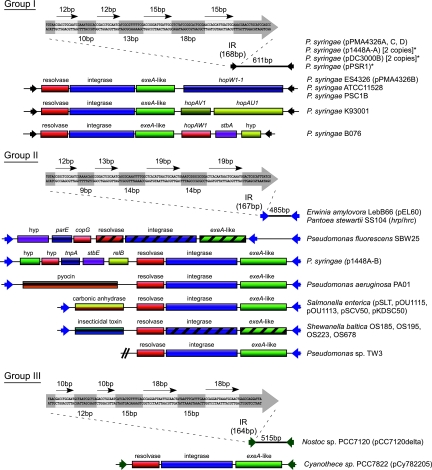Fig 1.
Genetic organization of the three major groups of E622/TnE622s. For all three groups, the E622 MITE is shown at the top, represented as a line with two arrowheads. The first 120 bases of one of the inverted repeats (IRs) are shown in a thick arrow; the four direct repeats are indicated by four thin arrows, and their nucleotide sequences are highlighted (light gray shading). The genetic content and organization of the related TnE622 islands are shown beneath each MITE. The group I E622/TnE622 elements contain the prototypical E622 element (611 bp), which appears to be restricted to P. syringae and is found mostly on plasmids. Some E622 elements identified are truncated and disrupted (asterisks). The group I TnE622 islands possess the resolvase-integrase-exeA-like (RIE) gene cassette between their IRs (black arrowheads), along with various genes, including type III effector genes (hopW1-1, hopAV1, hopAU1, and hopAW1) that are localized toward the 3′ end of the exeA-like gene. The group II E622 element, shown as a line with blue arrowheads, is 485 bp and is found in the phytopathogens Pantoea stewartii and Erwinia amylovora. The related group II TnE622 islands are represented in P. syringae, as well as in the human-pathogenic Pseudomonas aeruginosa and Salmonella enterica and the environmental species Shewanella baltica. Genes involved in virulence (pyocin, carbonic anhydrase, and insecticidal toxin genes) are passenger genes on the group II elements and are localized toward the 5′ end of the resolvase gene. Only a partial sequence for the Pseudomonas sp. TW3 TnE622 island is available, with the missing portion being shown as a double slash. The group III elements are represented only in the cyanobacteria, with the 515-bp E622 MITE being present in Nostoc sp. PCC7120 (shown as a line with green arrowheads). The only group III TnE622 island is present in Cyanothece spp., and it is the only element that lacks any genes other than the RIE cassette between its borders. Hatching indicates pseudogenes. All accession numbers are available in Table S1 in the supplemental material. hyp, hypothetical protein.

